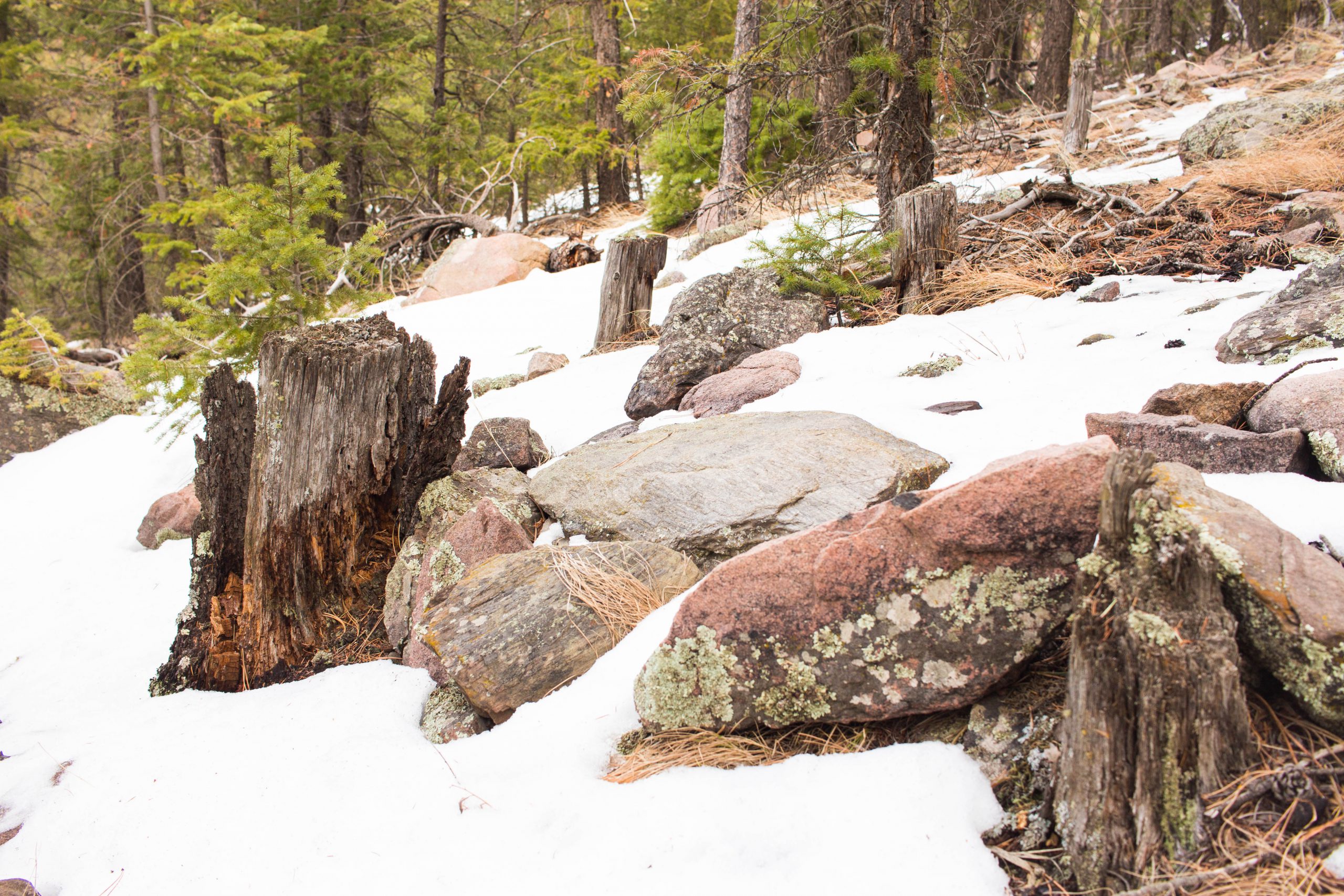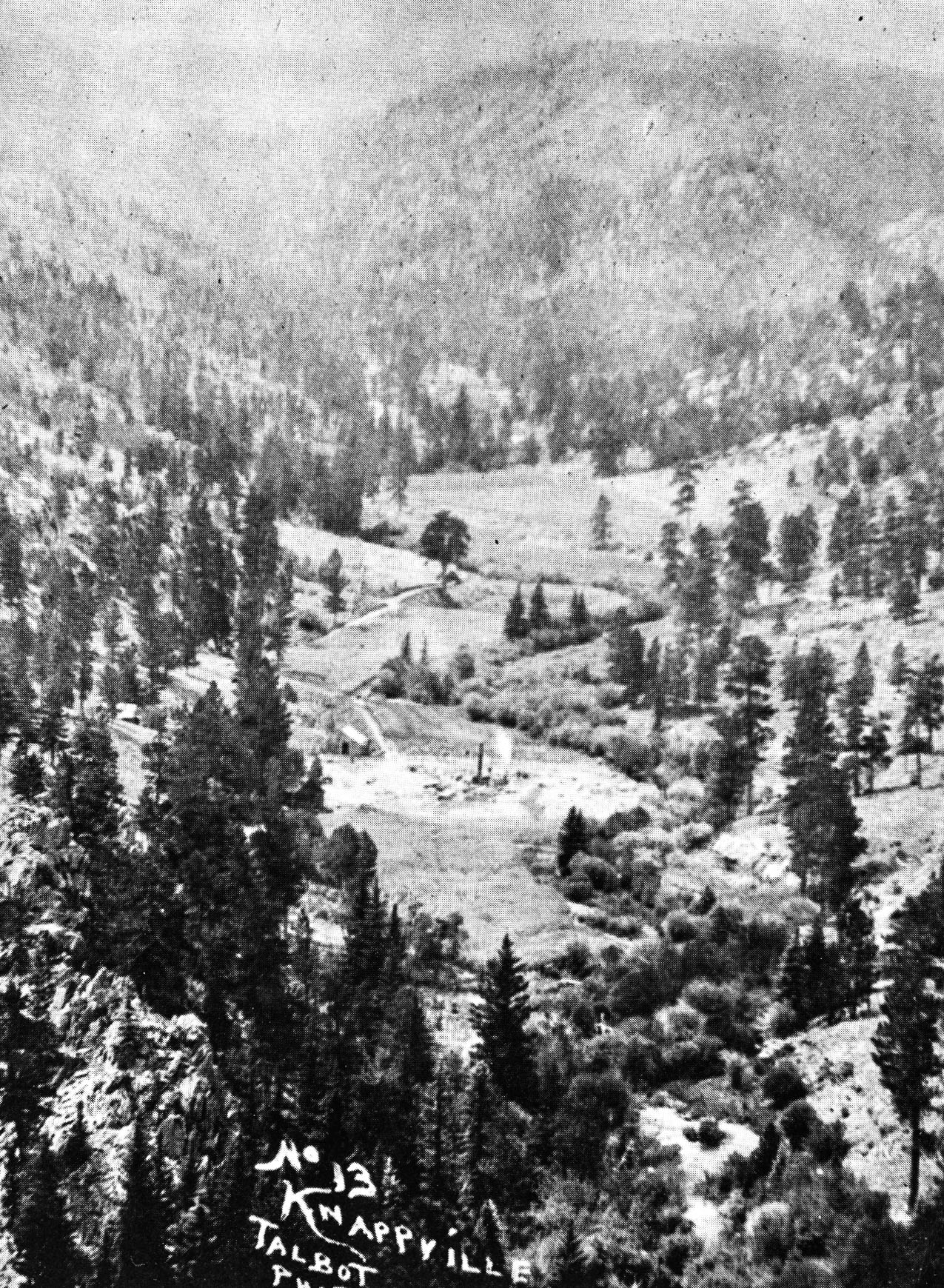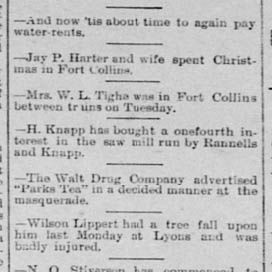If you wander the northern valleys on Sheep Mountain you may encounter a few hundred stumps of trees cut well over a century ago. These serve as a reminder of the mostly untold history of some of the Big Thompson’s first explorers, the early loggers.

Stumps on the slope of Sheep Mountain. The only evidence of the Knapp Sawmill that was at Idlewild from 1893-1896.
One of the first known groups to be documented logging in the canyon were the Osborn family. William B. Osborn came to Loveland in 1861 to farm along the Big Thompson River. In need of some wood to build a fence, he sent his son Milo up the Big Thompson in the mid 1860s to cut some trees at what is today known as Cedar Cove.1Oral History Transcript of Milo Allee Osborn.” Fort Collins History Connection: An Online Collaboration of the Fort Collins Museum and the Poudre River Public Library District. 2021. 01 Feb 2021.
…they stayed one winter in the first canyon up there — at the — well, you know where the Montrose is and they cut timber all winter long and then in the spring they put them in the river — that’s what they fenced the farm with that year. They floated them down the river. In high water.2Oral History Transcript of Milo Allee Osborn.” Fort Collins History Connection: An Online Collaboration of the Fort Collins Museum and the Poudre River Public Library District. 2021. 01 Feb 2021.
Milo Allee Osborn, Oral History Transcript, Fort Collins History Connection
The Osborn’s would be the first of many that would harvest trees from the canyon. After the construction of Rannell’s Toll Road in 1893 more parts of the canyon became accessible, and the first full time logging operations began. In the “History of the Big Thompson Canyon” the Knapp family lays claim that their sawmill operation was the first permanent settlement in the canyon.3Drake Home Demonstration Club, “History of the Big Thompson Canyon” 1939. p16-17
The Big Thompson River from the foothills to Estes Park was first permanently settled about 1893 when a saw mill was located at Harding Heights [Idlewild] by a party of men which included O.S. [Orren Smith Knapp] and Ira O. Knapp [Ira Owen Knapp].4Drake Home Demonstration Club, “History of the Big Thompson Canyon” 1939. p16-17
Ira O. Knapp, Glen Haven, History of the Big Thompson Canyon, 1939
Interestingly the Knapp’s family original saw mill location was none other than Harding Heights, better known today as Idlewild.
Idlewild History
Harding Heights
In the mid 1920s a new subdivision called Harding Heights would be partitioned off from the original Idlewild homestead. This would lead to the name of Harding Heights being used interchangeably with the Idlewild area until the 1940s.
Orren Knapp and his son Ira Knapp would spend three years at Idlewild cutting down timber to sell. They would eventually partner with John Rannells, who was the primary stockholder of the toll road leading through Idlewild.5Loveland Reporter, 27 Dec. 1894. Colorado Historic Newspapers Collection. Colorado State Library.
-H Knapp has bought a onefourth interest in the saw mill run by Rannells and Knapp.6Loveland Reporter, 27 Dec. 1894. Colorado Historic Newspapers Collection. Colorado State Library.
Loveland Reporter – December 27th 1894
This partnership resulted in the creation of the North Thompson Lumber Company.7The Loveland Register, 24 Jan. 1895. Colorado Historic Newspapers Collection. Colorado State Library.
-I.O. Knapp of the North Thompson Lumber Co., was a caller Monday. Mr. Knapp is also one of the Board of Directors of the Peoples Toll Road, Mining & Manufacturing Company8The Loveland Register, 24 Jan. 1895. Colorado Historic Newspapers Collection. Colorado State Library.
The Loveland Register – January 24, 1895
The details of where their sawmill was located are not known exactly, but based on where stumps are found, the sawmill was located in the southeast corner of the Idlewild homestead. This area has a large meadow, is near the Idlewild spring, and is close to where Rannells Toll Road once passed, which would have been an ideal area to locate their camp.
In 1896 the Knapps would move the sawmill to present day Glen Haven, which would become their permanent base of operation and future homestead.9Joseph G. Knapp, The Glen Haven Story, Johnson Published Company, Boulder, Colorado, 1967
Later in 1896, after two removed, the Knapps brought the saw mill to Glen Haven, and in 1897 made the claims on the land which became the subdivision comprising what is now the Glen Haven Resort.10Joseph G. Knapp, The Glen Haven Story, Johnson Published Company, Boulder, Colorado, 1967
Joseph G. Knapp, The Glen Haven Story, 1967

The Knapp sawmill in 1897 at what would later become downtown Glen Haven. This same sawmill would have been located at Idlewild just a year prior. Photo from The Glen Haven Story by Joseph Knapp.11Joseph G. Knapp, The Glen Haven Story, Johnson Published Company, Boulder, Colorado, 1967
- Oral History Transcript of Milo Allee Osborn.” Fort Collins History Connection: An Online Collaboration of the Fort Collins Museum and the Poudre River Public Library District. 2021. 01 Feb 2021.
- Drake Home Demonstration Club, “History of the Big Thompson Canyon” 1939. p16-17
- Loveland Reporter, 27 Dec. 1894. Colorado Historic Newspapers Collection. Colorado State Library.
- The Loveland Register, 24 Jan. 1895. Colorado Historic Newspapers Collection. Colorado State Library.
- Joseph G. Knapp, The Glen Haven Story, Johnson Published Company, Boulder, Colorado, 1967


